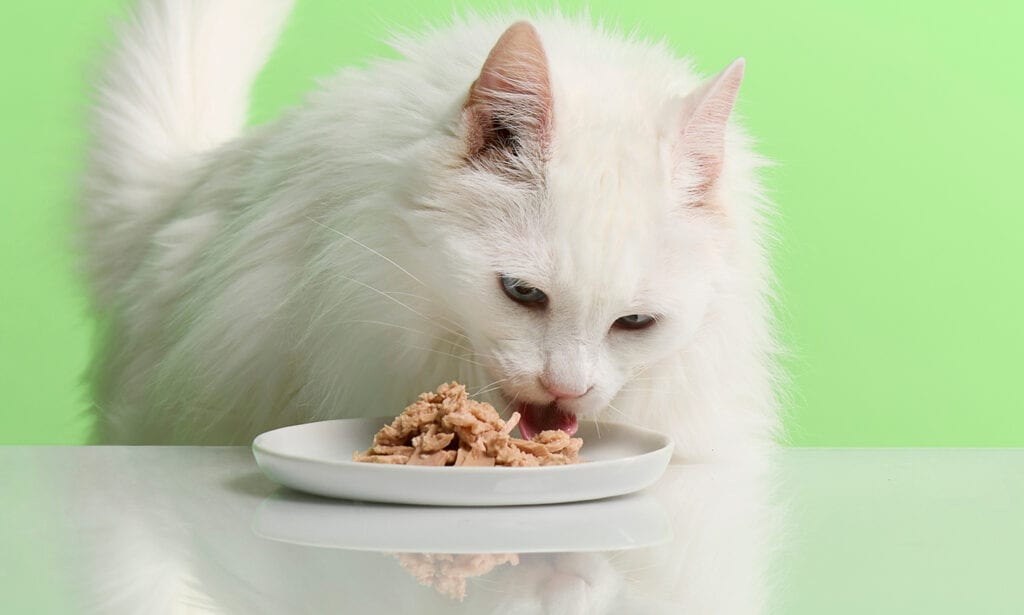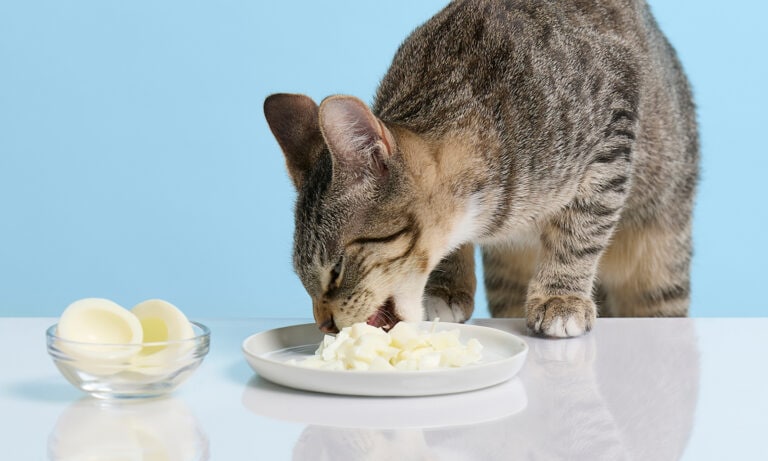Opening a can of tuna is the fastest way to make a cat come running. But can cats eat tuna? The answer is yes, they can. But even though cats love it and would likely prefer it over their own cat food, it’s not always the best choice for your cat’s health.
A little bit of unsalted, unseasoned tuna here and there likely won’t cause issues, but you don’t want to be feeding them too much. We spoke with two veterinarians about the benefits and risks of tuna, and how you can safely feed it to your cat as a treat.
Expert input provided by Dr. Christine Klippen, DVM, DABVP, emergency and critical care veterinarian at the Friendship Hospital for Animals in Washington, D.C.; and Dr. Leslie Sinn, DVM, ACVB, CPDT-KA, founder of Behavior Solutions in Ashburn, Virginia.
Can Cats Eat Tuna?
Click to jump to each section.
Should Cats Eat Tuna Fish?
Cats can eat tuna, but that doesn’t necessarily mean they should. There are some benefits of tuna for cats, but there are also risks you should be aware of.
At the end of the day, a little tuna here and there likely won’t cause problems—and will make your cat very happy—so it’s fine to give them some within moderation.
Benefits of Tuna for Cats
Let’s start with the good. Tuna does have some health benefits, including:
- It’s high in protein. Tuna is a good source of protein for your cat, and since cats are obligate carnivores, their diet should consist mostly of protein, Dr. Sinn says.
- It’s low in carbohydrates. On the flip side, tuna is low in carbohydrates. Cats lack an enzyme called glucokinase, which allows them to process dietary carbohydrates in the same way other animals do. Because of this, too many carbohydrates can predispose your cat to insulin resistance, Type 2 diabetes and obesity.
- It contains essential fatty acids. Tuna meat is rich in omega-3 fatty acids, like eicosapentaenoic acid (EPA) and docosahexaenoic acid (DHA). These fatty acids are important for maintaining a healthy coat and skin, and can also combat inflammatory conditions like heart disease and kidney disease.
- It’s motivating. Sinn says she often uses tuna as a way to get cats to take their medication because they like it so much.
Risks of Tuna for Cats
Is tuna harmful to cats? Let’s look at some of the risks of giving your cat tuna.
- Tuna is high in mercury. This may be the most well-known risk for humans, and it applies to your feline friends, Too much mercury can affect your cat’s neurological system, and potential damage may be irreversible.
- Tuna is nutritionally lacking. While tuna is high in protein and essential fatty acids, Dr. Klippen says it’s lacking in many essential vitamins and minerals. Because of this, it’s not a nutritionally balanced meal and can lead to deficiencies.
- Tuna can contribute to pansteatitis. The ratio of unsaturated fats (specifically polyunsaturated fats) to vitamin E is not adequate for cats, and this can cause a disease called pansteatitis (or yellow fat disease), Dr. Klippen says. This is characterized by inflammation of the fat tissue and can cause obesity, unwillingness to move, chronic pain and fever.
- Tuna overconsumption may lead to vitamin K deficiency. If too much regular cat food is replaced with tuna, it increases the risk of a vitamin K deficiency, which can lead to bleeding issues, says Dr. Klippen. This has also been seen in cats relying solely on tuna- or salmon-based commercial cat foods.
How to Safely Serve Tuna to Cats
To safely serve tuna to cats, consider two things: the type and the quantity.
Best Tuna for Cats to Eat
Both fresh and canned tuna are safe for cats to eat. Here’s what to look for in each kind.
Fresh tuna should be:
- Completely cooked (not raw): Raw tuna presents a risk of bacterial infection and is high in an enzyme called thiaminase that can break down thiamine—a B vitamin that maintains your cat’s nervous system and plays a role in carbohydrate In large amounts, this can lead to a thiamine deficiency, which contributes to heart conditions in cats, says Dr. Klippen. Cooking tuna destroys most of the thiaminase and is a safer option.
- Unseasoned: This means no salt, or other spices and seasonings.
Canned tuna should be:
- Packed in water instead of oil: Some canned tuna is packed with oil and flavorings to make them more palatable for humans, but oil and these additives aren’t good for your cat.
- Unseasoned: Again, this means no salt or other seasonings.
Type of tuna:
- Choose skipjack and canned light tuna: These have lower mercury levels than bigger types of fish, like albacore and yellowfin, so opt for these whenever possible.
How Much Tuna Can Cats Eat
Dr. Klippen says tuna should not make up more than 10 percent of your cat’s diet.
Based on that guidance, here are some maximum quantities depending on your cat’s weight.
5 lbs
157 kcal/day
0.4 ounces
7.5 lbs
210 kcal/day
0.6 ounces
10 lbs
260 kcal/day
0.7 ounces
12.5 lbs
298 kcal/day
0.8 ounces
15 lbs
354 kcal/day
1 ounce
17.5 lbs
396 kcal/day
1.1 ounces
20 lbs
440 kcal/day
1.2 ounces
How to Serve Tuna to Cats
As for how to serve tuna? You can give it to your cat straight up, or mix it with their wet food for a treat. A little tuna and the juice can also be used to make dry food more appealing.
You don’t want your cat to get used to this, though. Dr. Sinn says your cat might start turning their nose up at their regular food if they get used to a tuna-enhanced meal.
You can also find cat treats or tuna-based cat food that provides a more balanced diet. Some of those options include:
What To Do if Your Cat Eats Too Much Tuna
If your cat eats too much tuna, Dr. Sinn says closely monitoring them is the first step. In most cases, overdoing it one time would likely only result in an upset stomach, if anything. But if your cat got into excessive amounts of tuna, it can increase the risk of mercury poisoning.
You should head to the emergency vet right away if you see clinical signs that something is wrong, such as:
- Lack of coordination/wobbly gait
- Rapid eye movements
- Tremors or seizures
- Other abnormal behavior
These signs, as well as other neurological symptoms like a head tilt and dilated pupils, can also signal a thiamine deficiency, so it’s always best to get your cat checked out if you suspect anything is off.
FAQs About Tuna and Cats
Q:
Should cats eat canned tuna? Can I feed a cat canned tuna?
Q:
Is canned tuna healthy for cats?
Q:
Can I give my cat StarKist tuna?
Q:
Can cats eat raw tuna?
Q:
Can cats eat tuna steaks?
Can cats eat these other human foods?
Share:

















